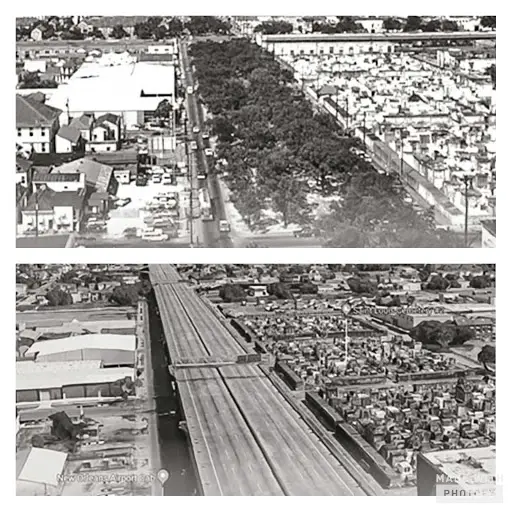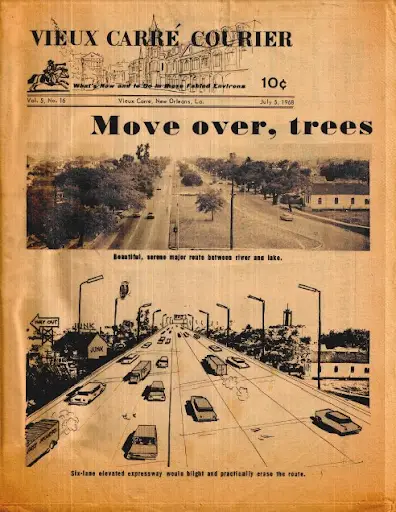At one point in America’s history, it was not unheard of for a predominantly black region to have established economic self-reliance. These neighborhoods were vibrant communities basking in an affluent local economy. Many times coined “Black Wall Street,” residents and business owners developed and maintained their own schools, restaurants, libraries, banks, and grocery stores. Unfortunately, similarities in their previous existence also lead to similarities in their eventual demise. From Tulsa’s Greenwood to Durham’s Parrish Street – systemic and social inadequacies proved its powerlessness for these business hubs. A thriving black neighborhood located in New Orleans was no exception.

A 2016 publication detailed the impact of highway I-10 on what was a successful black corridor on Claiborne Avenue. In the article, Claiborne Avenue was described as a grande avenue – a place of pride and belonging for the black community. Also unique to the corridor was its sheer size; the neutral ground was large enough for playing sports, like football and baseball, which happened often. The number of oak trees that lined the street was something to behold, setting a record for having the longest single strand of oak trees in the country.
Titled “Move Over Trees,” a 1968 rendering in a French Quarter publication demonstrated intention for the 6-lane highway to demolish more than only trees. The photo, furthermore, foreshadowed the plans to decimate a bustling, prestigious, and self-reliant black neighborhood.

Despite the fight of a powerless group of black residents and business owners, the highway was eventually completed. The tranquility of the neighborhood would soon be overthrown with concrete as long and as wide as the highway could touch. The new ambiance of the neighborhood overwhelmed with massive city traffic and the back and forth of importing business goods. Details revealed during a community event at The Hub on Claiborne Avenue addressed the aftermath: 326 black-owned businesses and over 500 oak trees – completely demolished.
Decades have passed and historic black neighborhoods such what has been seen on Claiborne Avenue remain in drastic economic decline. Can these historical districts be resurrected? Organizations such as Thrive New Orleans and the Cultural Innovation District believe that they can. Executive Director of Thrive New Orleans, Chuck Morse, recently expressed his excitement for The Hub: a coworking space newly located on the historic Claiborne Avenue. Selecting Claiborne Avenue for The Hub was very much intentional. Mr. Morse emphasized the desire to be strategically placed in efforts to work in collaboration with the community and with fellow businesses towards revitalization efforts. He says, “Launch NOLA (an initiative of Thrive New Orleans) is excited to be a part of bringing technical business assistance for aspiring start-up businesses. We invite people to The Hub – coworking space where businesses will have the resources to do business and also grow their business.”
A recent and well-attended event at The Hub gathered prominent business leaders and longtime residents to discuss the future of black business on Claiborne Avenue. Chuck Morse lead the panel discussion. Present for the meeting were lifetime residents, community activists, and local business owners: Judith Dangerfield, Al Jackson, Fred Johnson Jr., and Jerome Smith.
As a professional who has worked to strategically decrease the racial wealth gap, panelist Judith Dangerfield, founding owner of Metro Source LLC, has been vested in the impact of a prosperous financial future for Claiborne Ave. She spoke on the perceived intentions and economic impact of the I-10 freeway being built through Claiborne Ave:
“I think all of the businesses on the corridor were displaced. This was a corridor of neighborhood-serving businesses. This was businesses owned by people of color serving a community of people of color. Few of those businesses were able to survive what happened.”
“I want us to understand: this was not a construction project – this was about capital and the capital marketplace. This was about the imports and the exports and The Port being able to get the product to market. [They could] get the product to market without having to stop in our communities or do business in our communities…People are going to make money, and they are going to make money in spite of us.”
Panelist Fred Johnson Jr. furthered the sentiment of what could be experienced during the prime of the neighborhood with some of his fondest memories:
“The most beautiful thing that will be in my brain forever and ever were the oak trees…I can never accept that cement monstrocity over those trees. I mean…the trees were as such that it even affected the behavior of us. It gave off oxygen; it offered a place where you could cool off…the oak trees were far more beautiful than the oak trees on St. Charles Avenue.”
Upon entertaining questions from the audience, the panel was asked if Claiborne Avenue could ever be revitalized? Jerome Smith replied, “Jesus only came once.” Undeniably, the work will be hard and the commitment long. Nevertheless, initiatives described in the Cultural Innovation District work to develop a plan that the community can support and be hopeful for.
Asali DeVan Ecclesiastes, Director of Strategic Neighborhood Development of the New Orleans Business Alliance, gave a presentation regarding future efforts on Claiborne’s Corridor. Ms. Ecclesiastes also received feedback for what the panelist felt they would like to see in future efforts. It is important that Claiborne Avenue attract and uphold thriving small businesses and minority-owned businesses. It is, further, important for these businesses to serve as an anchor in the community; business owners are role models who give back to the community and inspire the next generation of black business owners and entrepreneurs.
The online site for the Claiborne Corridor Cultural Innovation District details their neighborhood revitalization plan. A brief breakdown on the exciting plans for Claiborne Avenue follow:
- BuildCLAIBORNE
“BuildCLAIBORNE is a comprehensive training and capacity building program to help current property owners, business owners, and emerging developers to revitalize residential and commercial properties in the Claiborne Corridor. It is designed to better ensure that the Corridor is redeveloped by, for and with the residents of the community.”
- LiveCLAIBORNE
“LiveCLAIBORNE leverages the City’s housing affordability plan, Housing for a Resilient New Orleans with The Network’s housing development partners to increase the supply of affordable housing in the Claiborne Corridor while creating jobs and contracting opportunities for small businesses.”
- The One Table
“The One Table is a coordinated funding mechanism designed to enhance the ability to attract and deploy capital effectively and efficiently in New Orleans’ urban core.”
- Green Infrastructure
“The CID can serve as a district that will lead the city and the nation in a more equitable form of urbanism, by mixing innovation and culture with green infrastructure strategies to create a vision of sustainable urban living for cities facing the full-on impact of climate change and sea level rising affecting most directly it’s poor and African-American communities.”
Contact The Hub: Coworking Space
Launch NOLA
1433 N. Claiborne Ave.
New Orleans, Louisiana 70116
(504) 546-7739
Contact The Cultural Innovation District
1240 N. Claiborne Ave.
New Orleans, Louisiana 70116
(504) 322-1633
Nicole Nixon is a dedicated wife and mother who values leadership and business. Motivated by her husband and her son, she is vested in the empowerment and positive commercialization of black men in America.









